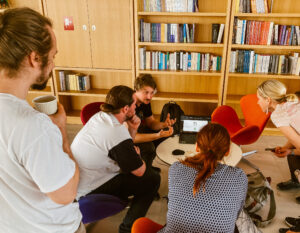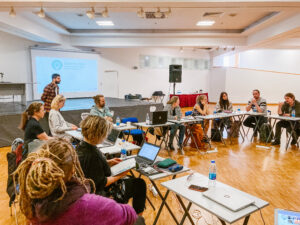DISCOVERY TRAIL project brought together different experts to achieve better understanding about how digital outdoor learning tool Avastusrada can be best used to support students ́ conceptual change in different aspects of biodiversity. This supports bridging the gap between formal education and nonformal learning.
Activities that were implemented to reach planned results
(a) Developmental work with the digital outdoor learning platform was guided by Tallinn University and there were se veral data collections points where feedback was collected from different target groups (core team members, teachers and non-formal education specialists, students) and several changes were made in the platform to make it more user friendly. Now https://avastusrada.ee/ platform can be used in 6 different languages, starting the trail using only link is provided and several bugs related to uploading pictures, seeing the map etc are fixed.
veral data collections points where feedback was collected from different target groups (core team members, teachers and non-formal education specialists, students) and several changes were made in the platform to make it more user friendly. Now https://avastusrada.ee/ platform can be used in 6 different languages, starting the trail using only link is provided and several bugs related to uploading pictures, seeing the map etc are fixed.
(b) Conceptual change perspective was used to create sample educational trails related to biodiversity concepts that can be used together with other methods during the learning process. These trails were created using participatory action research process where core team members, teachers and non-formal education specialists worked together to create and test the trails. A team from Finland (Helsinki University) who has a long experience of supporting the collaboration between teachers and non-formal education specialists led the process towards pre-created trails under the Avastusrada platform that can be further used in every country. Overview of these trails can be found here: Trails in Greece; Trails in Austria;Trails in Estonia; Trails in Finland
(c) Teacher training events with different scopes were organized through the project guided by Ellinogermaniki Agogi school in Greece. Based on these experiences a blueprint of how to plan similar trainings to support the use of Avastusrada is created. In the training event Avastusrada platform was introduced and through the experieces of sample trails, but also creating one´s own trails topics of biodiversity and supporting deeper learning experiences were introduced. Basic considerations for the use of Discovery Trails for the CPD of teachers and educators in non-formal institutions (Blue Print) can be found in our handbook Part III.
 (e) Manual (whitepaper) for teachers and non-formal education specialists was created skillfully coordinated by NaturErlebnisPark – Science Education Center in Austria. Manual allows us to share experiences with other educators who are planning to use Avastusrada with students of different ages, Morover manual has an extensive overview of biodiversity topics, but also developing trails as a participatory process and guidlines for preparing assignments that support more effective learning process. Read more from Discovery Trail handbook (manual), Short guide for educators or User manual of the Discovery Trail platform (Avastusrada)
(e) Manual (whitepaper) for teachers and non-formal education specialists was created skillfully coordinated by NaturErlebnisPark – Science Education Center in Austria. Manual allows us to share experiences with other educators who are planning to use Avastusrada with students of different ages, Morover manual has an extensive overview of biodiversity topics, but also developing trails as a participatory process and guidlines for preparing assignments that support more effective learning process. Read more from Discovery Trail handbook (manual), Short guide for educators or User manual of the Discovery Trail platform (Avastusrada)
Short summaries can also be found in Greek, Estonian and German languages.